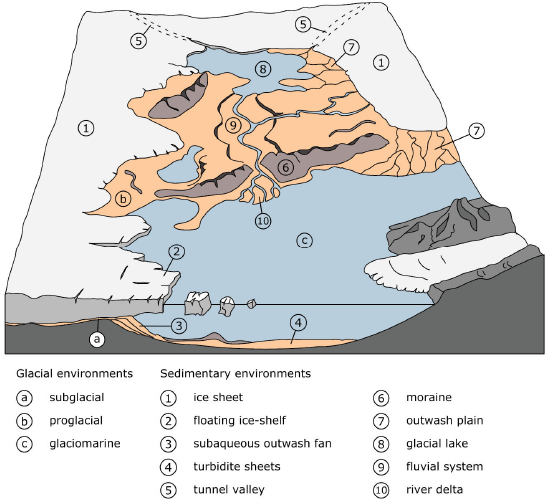Glaciations

Northern hemisphere glaciations have distinctly shaped the landscapes in Europe and North America. The interplay with sea level changes then led to a change in depositional setting from glaciolacustrine terrestrial to shallow marine, with a transition through shoreline processes and riverine operprint. The consequences in Northern Europe were quite different though.
In the Baltic Sea, with barriers to the ocean at Kattegatt, the effect of deglaciations went from heavy basal erosion, glacial thrusting and valley formation to the development of a marginal ice lake and later to a marginal sea with intermittent inflow of salty water. Holocene sediment is stratified and fine-grained, partially associated with contouritic systems.
The North Sea served as the main drainage plain from the dewatering glaciers, and sand was dominating the terrestrial domain. In the early phase, also an ice lake was forming, before rising sea level led to a southward shift of shoreline and in the late stage a strong estuaine circulation. While glacier reaching the North Sea have affected the subsurface by loading, erosion, fracturing, freezing and tunnel valley formation, the area of the North Sea always remained as a depositional sink due to ongoing subsidence.
Baltic Sea
Glacial thrusting
North Sea
Tunnel valleys and fracturing
Celtic Sea
Glacial erosion
Eastern Canada
...
Publications
Tóth, Zsuzsanna, McCarron S., Wheeler AJ., Wenau S., Davis S., Lim A., Spiess V. (2020) Geomorphological and seismostratigraphic evidence for multidirectional polyphase glaciation of the northern Celtic Sea. Journal of Quaternary Science 35, 465-478, https://doi.org/10.1002/jqs.3189.
Wenau, Stefan, Alves T. (2020) Salt-induced crestal faults control the formation of Quaternary tunnel valleys in the southern North Sea. Boreas. http://dx.doi.org/10.1111/bor.12461.
Leng, Wei, Dobeneck TV., Bergmann F., Just J., Mulitza S., Chiessi CM., St-Onge G., Piper DJW. (2018) Sedimentary and rock magnetic signatures and event scenarios of deglacial outburst floods from the Laurentian Channel Ice Stream. Quat. Sci. Rev., 186, 27-46. http://dx.doi.org/10.1016/j.quascirev.2018.01.016. (PDF)
Rebesco, Michele, Özmaral A., Urgeles R., Accettella D., Lucchi RG., Rüther D., Winsborrow M., Llopart J., Caburlotto A., Lantzsch H., Hanebuth TJJ (2016) Evolution of a high-latitude sediment drift inside a glacially-carved trough based on high-resolution seismic stratigraphy (Kveithola, NW Barents Sea). Quaternary Science Reviews, 147, 178-193, https://doi.org/10.1016/j.quascirev.2016.02.007.
Hepp, Daniel A., Hebbeln D., Kreiter S., Keil H., Bathmann C., Ehlers J., Mörz T. (2012) An east–west-trending Quaternary tunnel valley in the south-eastern North Sea and its seismic–sedimentological interpretation. J. Quaternary Science, 27, 844-853, https://doi.org/10.1002/jqs.2599.
Master Theses
Farag, Mohamed (2021) Facies Mapping of a Quaternary Tunnel Valley Infill - North Sea
Sierra, Gabriella (2020) Impact of Salt Tectonics and Glaciations on Sedimentation in the North Sea
Ogunleye, Opeyemi (2018) Quaternary glaciotectonic deformation of bedrock in the Arkona Basin to the Tromper Wiek, southern Baltic Sea – insights from processing and interpretation of 2D multichannel seismic reflection data
Bergmann, Fenna (2015) Analysis of sedimentary structures off E-Canada using hydroacoustic data from cruise MSM 39
Nachtweide, Christoph (2014) 3D model of Pleistocene sediments at the south-eastern margin of the Arkona Basin, Baltic Sea
Andresen, Katrine Juul, Hepp D.A., Keil H., Spiess V. (2022) Seismic morphologies of submerged late glacial to early Holocene landscapes at the eastern Dogger Bank, central North Sea Basin – implications for geo-archaeological potential. Geological Society, London, Special Publications, 525. https://doi.org/10.1144/SP525-2021-155
Özmaral, Asli, Abegunrina A., Keil H., Hepp D.A., Schwenk T., Lantzsch H., Mörz T., Spiess V. (2022) The Elbe Palaeovalley: evolution from an ice-marginal valley to a sedimentary trap (SE North Sea) . Quaternary Science Reviews, 282. https://doi.org/10.1016/j.quascirev.2022.107453.
Wenau, Stefan, Alves T. (2020) Salt-induced crestal faults control the formation of Quaternary tunnel valleys in the southern North Sea. Boreas. http://dx.doi.org/10.1111/bor.12461.
Portilho-Ramos, R. C., Cruz APS., Barbosa CF., Rathburn AE., Mulitza S., Venancio IM., Schwenk T., Ruhlemann C., Vidal L., Chiessi CM., Silveira CS. (2018) Methane release from the southern Brazilian margin during the last glacial: Scientific Reports, v. 8, https://doi.org/10.1038/s41598-018-24420-0.
Leng, Wei, Dobeneck TV., Bergmann F., Just J., Mulitza S., Chiessi CM., St-Onge G., Piper DJW. (2018) Sedimentary and rock magnetic signatures and event scenarios of deglacial outburst floods from the Laurentian Channel Ice Stream. Quat. Sci. Rev., 186, 27-46. http://dx.doi.org/10.1016/j.quascirev.2018.01.016. (PDF)
Lantzsch, Hendrik, Hanebuth, TJJ., Horry J., Grave M., Rebesco M., Schwenk T. (2017) Deglacial to Holocene history of ice-sheet retreat and bottom current strength on the western Barents Sea shelf. Quaternary Science Reviews, 173, 40-57, https://doi.org/10.1016/j.quascirev.2017.08.016.
Özmaral, Asli (2017) Climatically controlled sedimentary processes on continental shelves. Dissertation, xx. pp.. https://media.suub.uni-bremen.de/bitstream/elib/1355/1/00106314-1.pdf.
Rekant, Pavel, Bauch HA., Schwenk T., Portnov A., Gusev E., Spiess V. (2015) Evolution of subsea permafrost landscapes in Arctic Siberia since the Late Pleistocene: a synoptic insight from acoustic data of the Laptev Sea. arktos 1 (1), 1-15, https://doi.org/10.1007/s41063-015-0011-y.
Toth Zsuzsanna, Spiess V., Jensen JB. (2014) Seismo-acoustic signatures of shallow free gas in the Bornholm Basin, Baltic Sea. Continental Shelf Research. 88, 228-239, https://doi.org/10.1016/j.csr.2014.08.007.
Hepp, Daniel A., Hebbeln D., Kreiter S., Keil H., Bathmann C., Ehlers J., Mörz T. (2012) An east–west-trending Quaternary tunnel valley in the south-eastern North Sea and its seismic–sedimentological interpretation. J. Quaternary Science, 27, 844-853, https://doi.org/10.1002/jqs.2599.
